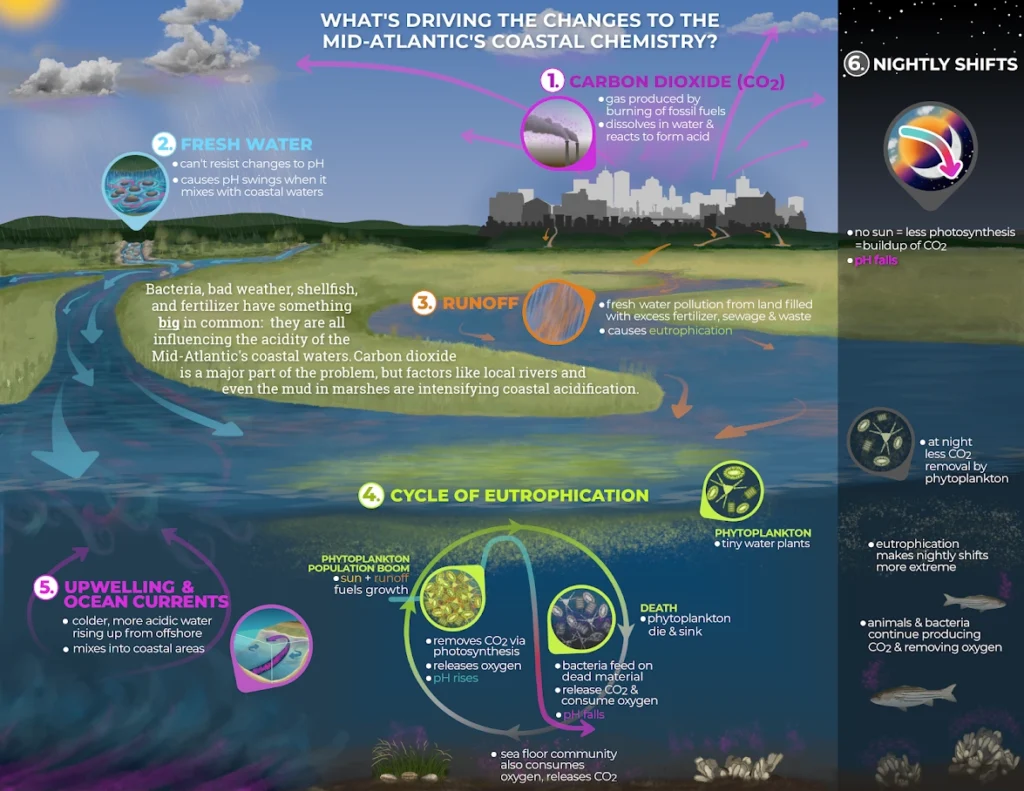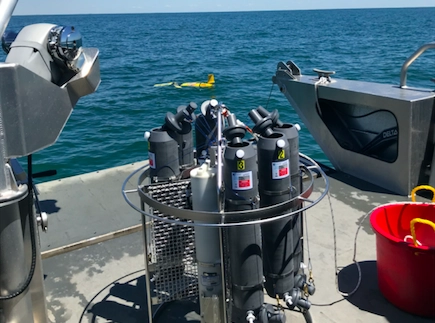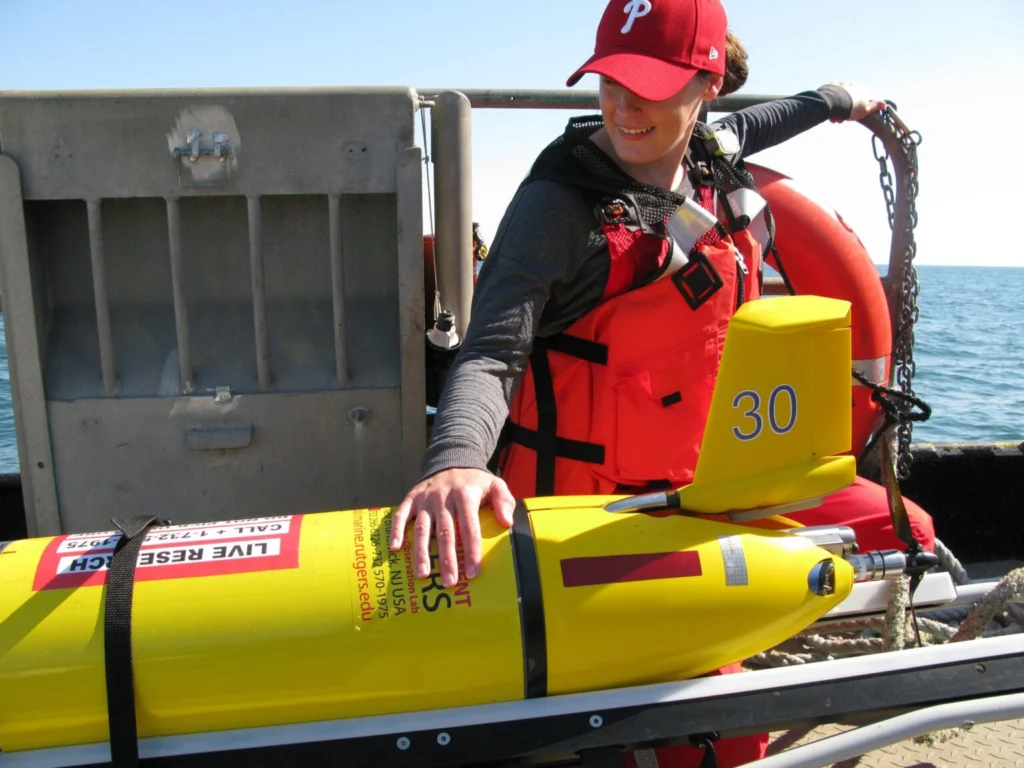Ocean Acidification Team
The RUCOOL Ocean Acidification Team develops and uses advanced observing technologies to: 1) Address hypotheses related to identifying the drivers, and relative importance of the drivers, of acidification on various time scales; 2) Identify high-risk areas and organisms vulnerable to ocean acidification to enable better management of essential habitats in future, more acidic oceans; 3) Determine natural variability that will provide a framework to better study organism response and design more realistic experiments; and 4) Enhance biogeochemical model robustness.
A GROWING NEED FOR OCEAN ACIDIFICATION
The rapid human-induced increase in atmospheric carbon dioxide (CO2) is associated not only with increasing global temperatures, but also higher rates of absorption of CO2 by the ocean that results in complex chemical reactions ultimately reducing seawater pH and increasing the ocean’s acidity. This process is termed ocean acidification, and it is occurring globally at unprecedented rates. In the coastal zone, acidification is influenced by additional drivers including nutrient loading, productivity-respiration cycles, freshwater inputs, and other coastal processes. Coastal acidification can be highly variable and episodic both spatially and temporally. Acidification can impact several important processes in marine organisms including rates of calcification (building external structures), metabolic physiology, reproduction and development, and indirect impacts through qualitative and/or quantitative changes in food source.

RUCOOL Contributions
Through laboratory and field experiments, we investigate organismal response to individual and synergistic changes in temperature and seawater pH. We also utilize ocean observing technologies (autonomous underwater vehicles or AUVs, sensor development, ship sampling, moorings) to determine natural environmental variability near organism habitats that will provide a framework to better study organism response, design more realistic experiments, and understand potential vulnerability of important economic living marine resources. Through academic-industry partnerships, we developed and integrated deep-sea pH sensors into AUVs called a Slocum gliders. These gliders can be deployed in a variety of ocean systems to track changes in the carbonate system over time and space, identify and quantify drivers of the coastal carbonate system, and aid in the development and improvement of biogeochemical and forecast models.



Ocean Acidification Resources
Saba GK, Bockus AB, Shaw CT, Seibel BA (2021) Combined effects of ocean acidification and elevated temperature on feeding, growth, and physiological processes of Antarctic krill Euphausia superba. Mar Ecol Prog Ser 665:1-18. DOI: 10.3354/meps13715
Wright-Fairbanks, E.K., Miles, T, Cai, W.-J., Chen, B., Saba, G.K. 2020. Autonomous observation of seasonal carbonate chemistry dynamics in the Mid-Atlantic Bight. Journal of Geophysical Research: Oceans 125(11): e2020JC016505, doi:10.1029/2020JC016505.
Saba, G.K., Wright-Fairbanks, E., Chen, B., Cai, W.-J., Barnard, A.H., Jones, C.P., Branham, C.W., Wang, K., Miles, T. 2019. The development and validation of a profiling glider Deep ISFET pH sensor for high resolution coastal ocean acidification monitoring. Frontiers in Marine Science 6: 664, https://doi.org/10.3389/fmars.2019.00664.
Cross, J.N., Turner, J., Cooley, S.R., Newton, J., Azetsu-Scott, K., Braby, C.E., Canesi, K., Chambers, C., Dugan, D., Goldsmith, K., Gurney-Smith, H., Harper, A., Jewett, L., Joy, D., King, T., Kurz, M., Morrison, R., Motyka, J., Ombres, E., Paguirigan, M., Regula-Whitefield, C.M., Saba, G.K., Silva, E., Smits, E., Vreeland-Dawson, J., Wickes, L. 2019. Building the Knowledge-to-Action Pipeline in North America: Connecting Ocean Acidification Research and Actionable Decision Support. Frontiers in Marine Science 6: 356, https://doi.org/10.3389/fmars.2019.00356.
Goldsmith, K.A., Lau, S., Poach, M.E., Sakowicz, G.P., Trice, T.M., Ono, R.C., Nye, J., Shadwick, E.H., St.Laurent, K.A., Saba, G.K. 2019. Scientific Considerations for Acidification Monitoring in the U.S. Mid-Atlantic Region. Estuarine, Coastal and Shelf Science 225: 106189, https://doi.org/10.1016/j.ecss.2019.04.023.
Saba, G.K., Goldsmith, K.A., Cooley, S.R., Grosse, D., Meseck, S.L., Miller, W., Phelan, B., Poach, M., Rheault, R., St. Laurent, K., Testa, J., Weis, J.S., Zimmerman, R. 2019. Recommended Priorities for Research on Ecological Impacts of Coastal and Ocean Acidification in the U.S. Mid-Atlantic. Estuarine, Coastal and Shelf Science 225: 106188, https://doi.org/10.1016/j.ecss.2019.04.022.
Saba, G.K., Schofield, O., Torres, J.J., Ombres, E.H., Steinberg, D.K. 2012. Increased feeding and nutrient excretion of adult Antarctic krill, Euphausia superba, exposed to enhanced carbon dioxide (CO2). PLoS ONE: doi:10.1371/journal.pone.0052224.
